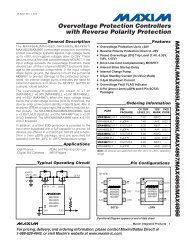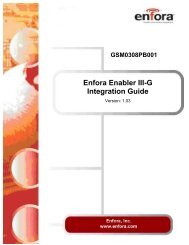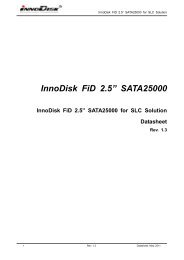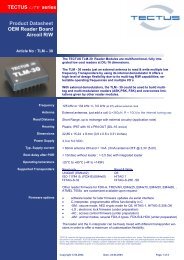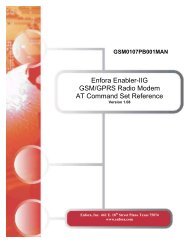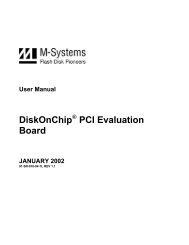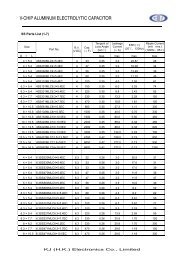AT+i Programmer's Manual - SE Spezial-Electronic AG
AT+i Programmer's Manual - SE Spezial-Electronic AG
AT+i Programmer's Manual - SE Spezial-Electronic AG
Create successful ePaper yourself
Turn your PDF publications into a flip-book with our unique Google optimized e-Paper software.
SerialNET Theory of Operation<br />
bytes to buffer. If additional bytes are received on the serial port before the connection is<br />
established, they are discarded.<br />
iChip will dial-up the ISP to establish an Internet connection before attempting to open<br />
the server socket.<br />
iChip closes its listening socket (if one is defined by the LPRT parameter) to avoid<br />
remote client devices from connecting during this session.<br />
The remote server‘s IP and port are part of the SerialNET mode configuration<br />
parameters. Once a data connection is established, data can flow freely between the local<br />
client device and the remote server. If a connection cannot be obtained, eventually the<br />
client device‘s data will be discarded (similar to the case of a device transmitting serial<br />
data without a serial cable connected). Data continues to flow until a predefined activity<br />
termination event is triggered, upon which the remote connection is dropped.<br />
28.5 Automatic SerialNET Server Wake-Up Procedure<br />
A SerialNET client may be configured to wake up a remote SerialNET server provided it<br />
has its phone number. The SPN parameter is used to store this wakeup number.<br />
When SPN contains a phone number and no Host Server Name and/or IP are defined, the<br />
SerialNET client tries to retrieve them from the registration e-mail of a remote SerialNET<br />
server. When characters are received from the host port, the SerialNET client dials the<br />
SerialNET server and then hangs up, causing the server to connect to its ISP, send a<br />
registration e-mail containing its IP address and local port, and open a listening socket on<br />
that port.<br />
The client, after waking up the server, connects to its ISP and starts polling the predefined<br />
mailbox for the server‘s registration e-mail. Once this e-mail arrives, the client opens a<br />
socket to the IP address and port defined in the e-mail. The SWT (SerialNET Wakeup<br />
Timeout) parameter defines how long iChip will wait for this procedure to conclude<br />
before stopping. Data then flows until a predefined activity termination event is triggered,<br />
upon which the remote connection is dropped.<br />
28.6 Transmit Packets<br />
Data originating in the local device is buffered, packetized, and transmitted to the remote<br />
system over the network. Packets are formed as a result of meeting at least one of the<br />
following criteria:<br />
A predetermined number of bytes has been received from the local link (MCBF).<br />
The TCP/IP connection MTU was met.<br />
A predetermined flush character has been received (FCHR).<br />
A predetermined inactivity timeout event was triggered (MTTF).<br />
Until one of these events occurs, data is buffered in the iChip. When an event occurs, a<br />
packet is transmitted. The event parameters are configured by setting <strong>AT+i</strong> parameters<br />
prior to initiating SerialNET mode. When a UDP connection is used, data packets are<br />
atomic, maintaining their original size. When a TCP connection is used, packets can be<br />
combined before being actually transmitted. This follows from the stream nature of the



